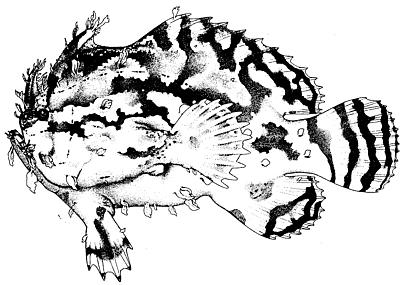|
Sargassumfish (Histrio histrio) - Wiki
| 제목: | Sargassumfish (Histrio histrio) - Wiki
| |

| 해상도: 400x285
파일크기: 30316 Bytes
등록시간: 2007:08:14 00:42:28
|
Sargassumfish
From Wikipedia, the free encyclopedia
[Photo] source:http://www.nefsc.noaa.gov/lineart/sargassumfish.jpg
The sargassumfish, Histrio histrio (literally, "The Actor"), is a frogfish of the family Antennariidae, found close to the surface amongst floating sargassum weed in all subtropical oceans. Its length is up to 20 cm.
The sargassumfish has numerous fleshy weed-like dermal appendages which allow it to blend in with the floating sargassum weed in which it is usually found. It is a deep-bodied shapeless species, with long and thickened pectoral and pelvic fins which serve as limbs allowing the fish to 'walk' amongst the seaweed fronds.
They lie in wait for passing crustaceans and small fish, lunging out suddenly to snap up their next meal.
http://en.wikipedia.org/wiki/Sargassumfish
| The text in this page is based on the copyrighted Wikipedia article shown in above URL. It is used under the GNU Free Documentation License. You may redistribute it, verbatim or modified, providing that you comply with the terms of the GFDL. |
|
댓글 |
|---|
| | 손님 |
|
Scientific Name: Histrio histrio (Linnaeus, 1758)
Common Names:
English – Sargassumfish, Mouse Fish, Sargassum Anglerfish, Frogfish, Frog Fish, Sargassum Fish, Sargassum Frogfish, Marbled Angler
French – Baudroie, Antennaire des Sargasses, Baudroie, Pêcheur des Sargasses, Poisson-pêcheur des Sargasses
Spanish – Pez sargazo, Pez Sargazo, Rana, Rana, Sapo, Sapo
Synonyms:
Antennarius inops Poey, 1881
Antennarius lioderma Bleeker, 1864
Antennarius nesogallicus Cuvier 1831
Antennarius nitidus Bennett, 1827
Cheironectes pictus vittatus Richardson, 1844
Chironectes arcticus Düben & Koren, 1846
Chironectes barbatulatus Eydoux & Souleyet, 1850
Chironectes barbatulus Eydoux & Souleyet, 1850
Chironectes laevigatus Cuvier, 1817
Chironectes nesogallicus Valenciennes, 1837
Chironectes pictus Valenciennes, 1837
Chironectes sonntagii Müller [J. W. von] 1864
Chironectes variegatus Rafinesque, 1814
Histrio jagua Nichols, 1920
Lophius calico Mitchill, 1818
Lophius cocinsinensis Shaw, 1812
Lophius geographicus Quoy & Gaimard, 1825
Lophius gibbus Mitchill, 1815
Lophius histrio Linnaeus, 1758
Lophius histrio marmoratus Bloch & Schneider, 1801
Lophius laevis Latreille [P. A.] 1804
Lophius pelagicus Banks, 1962
Lophius raninus Tilesius, 1809
Lophius tumidus Osbeck [P.] 1765
Lophius arcticus Düben [M. W. von] 1845 |
^o^
동물그림창고 똑똑전화 누리집
^o^
|
|
|